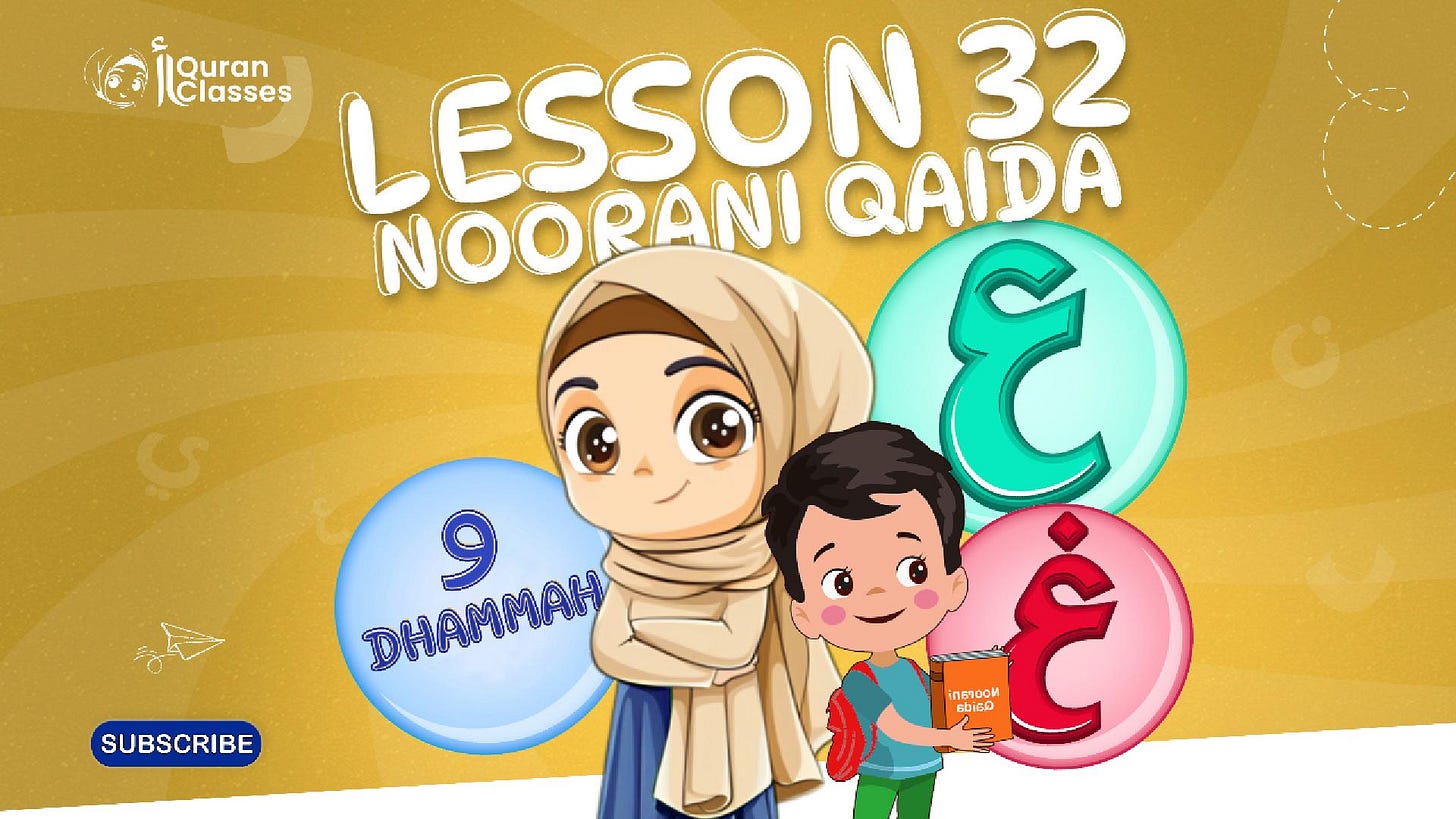Bayt Al-Quran: Noorani Qaida-Lesson#32| Friday
Mastering the Bold Sounds: عُ (ʿAin) & غُ (Ghain) with the Dammah Vowel (ـُ)
Little Reciters — It’s Lesson 32!
After journeying through bold sounds and deep echoes, it’s time to unlock two of the most graceful and expressive letters in the Arabic alphabet: عُ (Ain) and غُ (Ghain). These letters swirl from the throat like a gentle stream and bring a beautiful rhythm to the words of the Quran.
In this lesson, your child will learn to:
Pronounce the rounded Dammah sound on Ain and Ghain
Identify and trace the letters with correct form and placement
Begin recognizing these letters in simple combinations
We’re nearing the final stretch of our Dammah series, and your child’s progress is blossoming beautifully. With every lesson, their connection to the Quran is deepening — not just through reading, but through love, effort, and understanding.
So let’s take this next step with curiosity, encouragement, and a lot of joyful repetition!
Key Learning Objectives
Recognize the Arabic letters ع (Ain) and غ (Ghain) with the Dammah vowel
Correctly pronounce the rounded “u” sounds: عُ and غُ
Practice tracing the unique throat-based shapes of Ain and Ghain
Differentiate between similar-looking letters by sound and form
Strengthen visual and auditory connection between letter and vowel
Build confidence in reading letter-sound combinations with fluency
🎥 Watch Today’s Lesson Video:
Let’s Practice with Joy – Activity Sheet Time!
This week, our little learners are diving into the deep and rich sounds of عُ and غُ, and what better way to reinforce them than with a colorful, hands-on activity sheet! Designed to help children recognize, trace, and pronounce these throat letters with the Dammah (ـُ), the sheet includes:
Letter tracing for shape recognition and motor skills
Sound-matching games to distinguish عُ from غُ
Mini word building with Dammah-based syllables
Whether it’s part of your after-class routine or a quiet-time learning moment, this printable sheet is a fun and focused way to build confidence—one sound at a time. So grab those crayons and watch your child master these unique letters with a smile!
Playful Activities
Hide cards with عُ and غُ around the room. Each time your child finds a card, they have to say the sound aloud before collecting it in their “treasure basket.” Add small toys or stickers as rewards for each correct pronunciation.
🗣️ 2. "Bubble Sound Pop" Game
Say a mix of Dammah sounds aloud (like عُ, غُ, بُ, etc.). When your child hears عُ or غُ, they clap or “pop” a pretend bubble in the air. This game helps sharpen listening and sound recognition in a fun, movement-based way.
🎨 3. "Letter Masking Art"
Use painter’s tape to form ع and غ on a piece of paper. Have your child color over the paper freely using crayons or paint. When you peel off the tape, the letter appears like magic! Add the Dammah (ـُ) on top and say the sound aloud together.
We'd Love to Hear About Your Child’s Throaty Adventure!
How did your little learner enjoy discovering the deep, echoing sounds of عُ and غُ today? Whether it was a giggle during the Bubble Sound Pop or a proud “aha!” while tracing those tricky throat letters — we’d truly love to hear about it!
Send us a quick comment, a picture of their activity sheet, or even a short video of your child trying out these bold new sounds. Teacher Noura would be delighted to celebrate their efforts and share a kind word of encouragement, inshaAllah.
With every new Dammah sound they conquer, your child is building a strong, confident connection with Arabic reading — one letter, one smile, one sound at a time. 🌟
You’re guiding them beautifully, and it shows. Keep going — the journey is only getting brighter!



